Posted by James (admin) on 12th October 2012
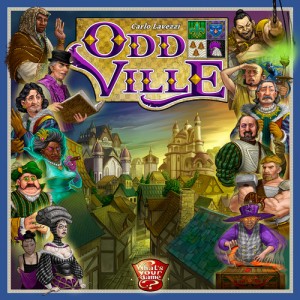 From reading the rules, Oddville looks like an interesting mix of using cards to gain resources and tile-laying to build a city. Now that may sound like a lot of other games but the game mechanics of Oddville look inventive and slick.
From reading the rules, Oddville looks like an interesting mix of using cards to gain resources and tile-laying to build a city. Now that may sound like a lot of other games but the game mechanics of Oddville look inventive and slick.
On your turn, you play 1 card from your hand or build 1 building. When a player plays a card, they can do 1 of the 3 things on the card – gain the cash shown, gain 1 of the resources shown, or gain 1 building from the 6 building cards on display (the card affects the price). I always like games where cards can be used for multiple purposes as it usually creates some interesting decision-making on how to combine the cards best and, hopefully, can be combined differently to give you alternate options if you need to change strategy.
When a player chooses to gain one of the resources on their played card, they place one of their workers on one of the market prices for that resource which are limited in number – this determines how much the resource costs plus the worker shows the player has that resource until they spend it to build a building. This should make for interesting competition over the lowest prices.
When a player chooses to gain a building, their card determines which of the 6 buildings on display are free and which will cost cash – the ones on the left (the oldest) are the ones most likely to be free. This sort of mechanic is in other games (like Gloria Mundi) and I like it because it makes newly added buildings (added to the right-end of the row) generally more expensive. Read the rest of this entry »
Tags: board game news, Board Games, board gaming, Essen, Oddville, Spiel 2012, What's Your Game
Posted in Board Games, Essen Spiel 12, Oddville, On the Radar | No Comments »
Posted by James (admin) on 11th October 2012
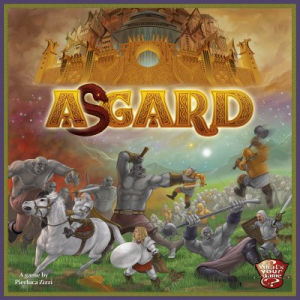 What’s Your Game have published some great games in the past (like Vinhos and one of my favourite worker placement games Vasco de Gama). After releasing no new games last year, it’s great to see they have two this year. Asgard is a viking-themed, worker placement game where players place workers (influence) on different locations (gods) but there’s a lot more to it too and sounds like a meaty eurogame. The board shows the 10 gods (5 light and 5 dark), the various worlds, Asgard and Valhalla.
What’s Your Game have published some great games in the past (like Vinhos and one of my favourite worker placement games Vasco de Gama). After releasing no new games last year, it’s great to see they have two this year. Asgard is a viking-themed, worker placement game where players place workers (influence) on different locations (gods) but there’s a lot more to it too and sounds like a meaty eurogame. The board shows the 10 gods (5 light and 5 dark), the various worlds, Asgard and Valhalla.
The worker placement aspect is a bit different to most worker placement games as players first secretly select on which gods they will place each of their workers (by selecting god cards equal to the number of workers) then they take turns revealing one of their card and placing a worker on one of the available actions of that god (or placing it in Asgard instead if they prefer which has its own benefits), and then they take turns activating one of their workers. (It reminds me a bit of Era of Inventions (a great game from 2011) where players take turns placing their workers and then take turns activating them and the order of activation made a big difference too – but Asgard goes a step or two further.) It sounds like there will be lots of decision-making required as you consider where others will likely place their workers (as there are limited spaces on each god), which actions will work well together, which actions you will need to do before another player, etc. Players will gain and spend workers during the game too so they will need to manage these. Plus, the first worker used on each god earns a light/dark token which are used to buy warriors/giants and new workers (which can trigger battles).
Read the rest of this entry »
Tags: Asgard, board game news, Board Games, board gaming, Essen, Spiel 2012, What's Your Game
Posted in Asgard, Board Games, On the Radar | No Comments »
Posted by James (admin) on 8th October 2012
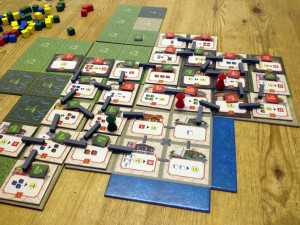 Singapore is an interesting mix of tile-laying and economic/resource management. Players are aiming to score the most victory points (VPs) which are earned through moving your worker(s) and using buildings. The board consists of several sections which can be combined in many ways which gives some variety in replay. Most squares on each board section show the cost of building on that square (£1-£4) . At the start of the game, there are 4 neutral buildings – every round players build one building and connect them to neighbouring buildings.
Singapore is an interesting mix of tile-laying and economic/resource management. Players are aiming to score the most victory points (VPs) which are earned through moving your worker(s) and using buildings. The board consists of several sections which can be combined in many ways which gives some variety in replay. Most squares on each board section show the cost of building on that square (£1-£4) . At the start of the game, there are 4 neutral buildings – every round players build one building and connect them to neighbouring buildings.
Players start with some money, 5 VPs and one worker. At the start of each round, a number of buildings are revealed (equal to the number of players plus one). Then, the player in last place takes one coloured marker from each player and places them on vacant lots that neighbour any existing buildings. These markers show where each player will build a building that round and the cost on the square dictates how much it will cost them.
Starting with the player in last place (and then going clockwise), players select one of the available buildings and pay the cost to build it on their marked square (leaving their coloured marker on it to show they own it). If a player can not afford the building cost, they must exchange 1 VP for £2 until they can (or they get the building for free if they have no cash and no VPs).
Read the rest of this entry »
Tags: board game news, Board Games, board gaming, Peer Sylvester, Singapore, White Goblin Games
Posted in Board Game Review, Board Games, Singapore | 4 Comments »
Posted by James (admin) on 7th October 2012
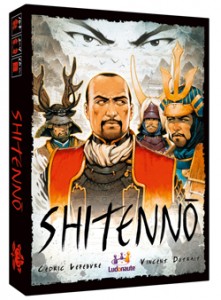 Recently, I reviewed Shitenno and mentioned I thought it would work well as a 2-player game. Since then, I had the chance to try this out and I’m pleased to say it does work well with 2 players as there are fewer combinations of cards and outcomes to try to consider so you can make a more informed decision. Rather than having to make one offer of cards at a time, with two players it is a simple one-player-splits-whilst-the-other-chooses process.
Recently, I reviewed Shitenno and mentioned I thought it would work well as a 2-player game. Since then, I had the chance to try this out and I’m pleased to say it does work well with 2 players as there are fewer combinations of cards and outcomes to try to consider so you can make a more informed decision. Rather than having to make one offer of cards at a time, with two players it is a simple one-player-splits-whilst-the-other-chooses process.
Compared to the 4-player game, I found I could better work out which cards I wanted, plus I had more insight into which cards I didn’t want my opponent to have too. Even with this knowledge, creating a balanced offer of cards/role so that my opponent didn’t automatically take the offer I that really wanted still remained enjoyably difficult. Also, selecting which role is offered with each group of cards is made more interesting because the person making the offer only uses 2 of the 4 roles each turn – in fact, I think I had more difficulty choosing which roles to offer than splitting the cards (in a good way as it was an interesting choice to make).
The inherent downside to a directly competitive 2-player game is that what you lose the other player gains and vice versa (a kind of ‘tug-of’war’ play pattern), and you only need to watch a single opponent. I was thinking that an invisible 3rd player would be good to make things a bit more ‘lumpy’ – I’ve noticed over the years, I like an invisible 3rd player in 2-player game (Alhambra was my first experience of it) but just so long as it is slightly predictable and not purely random. If it’s totally random, one player can suffer through no fault of their own just because they had no way to include the 3rd player’s actions into their plans, and this unbalances the game.
Read the rest of this entry »
Tags: board game news, Board Games, board gaming, Shitenno
Posted in Board Games, Shitenno, Thoughts On | No Comments »
Posted by James (admin) on 3rd October 2012
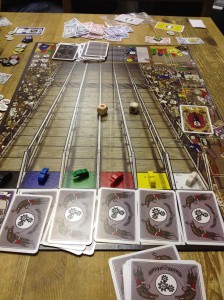 I’m usually a bit skeptical about horse racing games as I find they can be quite dry and/or overly complicated; however, Horse Fever surprised me. In Horse Fever, each player is trying to earn as many victory points (VPs) as possible.
I’m usually a bit skeptical about horse racing games as I find they can be quite dry and/or overly complicated; however, Horse Fever surprised me. In Horse Fever, each player is trying to earn as many victory points (VPs) as possible.
Each round, players get cards, make a bet, play cards on horses (without revealing them), make another bet, reveal the cards and then the race takes place. In the simpler version of the game that we played players are dealt cards – some cards help horses (they get a good start, move further when sprinting, etc.) and some hinder horses (they don’t move when in the lead, all beneficial cards are ignored, etc.) In the full version of the game, players buy cards instead of bring dealt them (which I think would be the best way) – you can also get target cards (extra VPs if you meet the conditions at the end of the game), assistant cards (discounts on some cards, regular income, etc.), stable cards (you own a horse and get cash if 1st, 2nd or 3rd), horse cards (on-going benefit to your horse if you have a stable). You can also take out loans and buy cards from other players. Read the rest of this entry »
Tags: board game news, Board Games, board gaming, Horse Fever
Posted in Board Game Review, Board Games, Horse Fever | 3 Comments »
Posted by James (admin) on 1st October 2012
A few more forthcoming games that have taken my interest recently. (I’ve combined all the Spiel games on my radar on my Essen 2012 page too.)
Tzolk’in: The Mayan Calendar (Czech Games Edition)
Tzolk’in is a game where the turning of cogs are at the very centre of a worker placement game. Players place workers on small cogs which are located around a central, large cog. The large cog is turned as the game progresses and this turns the small cogs. Players spend corn to place their workers (filling the cheapest slot) on the cog where they want to place a worker. When a player, removes a worker, they get a benefit based on where they player is on the cog – the longer they remain on a cog, the greater the benefit. One cog has an interesting element to it where a player can take corn even if it is not quite ready but at the risk of angering the gods. There’s still a lot of information to come about this game but, so far, it sounds really interesting.
1969 (Cranio Creations)
A resource gathering, dice-rolling and card playing game where players are trying to reach the moon in a space race before 1969. Players gather scientists, cash and intelligence cards to prepare for different missions. They only get one chance at each mission which scores VPs. To undertake a mission the player rolls the 5 dice (and moves an appropriate number of spaces along the mission track); however, then all players get to play intelligence cards that move the active player back down the track (and the active player gets to play cards to move themselves forwards) – all cards are played simultaneously. The biggest mission is the moon mission and completing any other mission means a player can start further along the moon mission track. Sounds very good (reminds me slightly of Airships by Queen Games – a game I really like – not through any specific game mechanic, but just in trying to prepare to achieve tasks).
Check out the details and rules at Cranio Creation’s web site: bga.me/1969
Blackrock City (Blackrock Editions)
Blackrock Editions published a great game called The Boss a couple of years ago. This year they are releasing Blackrock City – a wild west game where players bid their outlaws. The winner of a round moves their outlaw chief a number of spaces (equal to their bid minus the lowest bid) and takes gold from the city they land on. The player who is second in a round gets a silver from the stagecoach. However, there are some interesting twists: the outlaws you bid with have a limited usage; players can not bid the same as the leading bid; each bid moves the sheriff around the cities which foils outlaws; and, cities have different effects after they have been robbed.
It sounds like a short, fast bidding game but with some interesting thinking around the bidding as players try to work out how to win rounds (or at least move the sheriff to annoy others) whilst positioning their outlaw on a beneficial city. One interesting feature is that, twice per game, each player can place a 15 second sand timer in front of an opponent and that player must take their go in that time. Also, I like how it plays 2-player with an invisible 3rd player.
Check out the details and rules at Blackrock Edition’s web site: bga.me/brc
Tags: 1969, Blackrock City, board game news, Board Games, board gaming, Essen, Spiel 2012, Tzolk'in
Posted in 1969, Blackrock City, Board Games, Essen Spiel 12, On the Radar, Tzolk'in | No Comments »
Posted by James (admin) on 29th September 2012
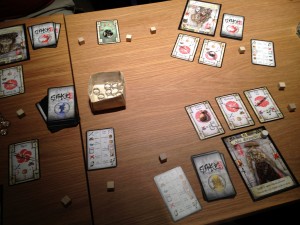 Sake and Samurai is a card-based game where players are each drunk samurai fighting each other to the last man. In front of each player is a card showing their samurai and there are some wooden blocks in between each player’s samurai to show how far apart they are. In the centre of the table is a cup holding a limited amount of clear beads (based on number of players) which represent the drink sake. When the game ends, the goal is to the drunkest remaining Samurai alive.
Sake and Samurai is a card-based game where players are each drunk samurai fighting each other to the last man. In front of each player is a card showing their samurai and there are some wooden blocks in between each player’s samurai to show how far apart they are. In the centre of the table is a cup holding a limited amount of clear beads (based on number of players) which represent the drink sake. When the game ends, the goal is to the drunkest remaining Samurai alive.
Players each have a hand of cards (events, weapons, minions, etc.) and each card can be used for any of its 4 values: Attack, Defence, Movement and Drinking. Players take turns carrying out one of four actions by using a weapon card already laid down or by playing a card from their hand:
- Attack: Play a card and add its attack rating to the rating of an equipped weapon card to give the total attack strength. (A samurai must be the right number of steps away to use a weapon.)
- Move: Play a card and move the samurai a number steps (equal to the card’s move rating) closer to a neighbouring samurai (and further from the other). This is done by moving the number of wooden markers from one side of the samurai to the other. Read the rest of this entry »
Posted in Board Game Review, Board Games, Sake and Samurai | No Comments »
Posted by James (admin) on 27th September 2012
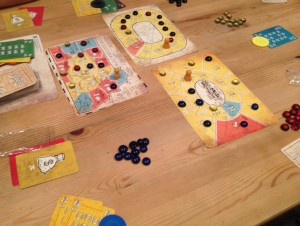 I like the idea of using poker hand mechanics in a game. At Spiel 2011, I played a game that used poker hands but it turned out to be average so I was really intrigued when, just 5 minutes later, I noticed Montana on the Cambridge Games Factory. With a cheap price, I decided to pre-order it and it arrived a couple of months ago.
I like the idea of using poker hand mechanics in a game. At Spiel 2011, I played a game that used poker hands but it turned out to be average so I was really intrigued when, just 5 minutes later, I noticed Montana on the Cambridge Games Factory. With a cheap price, I decided to pre-order it and it arrived a couple of months ago.
Montana is an area control game where players compete for control over 3 areas each round, and the player with the most victory points (VPs) at the end of the game wins. Players score VPs for (a) areas they control with a bonus for having multiple connected regions, (b) if they control their secret objectives, (c) if they control the most red regions, and (d) if they control the most blue regions.
Players start the game with some cards (numbered 1-12 in five colours x 2) as well as two secret objectives (for which they’ll score extra points if they control that specific region). On the table are 3 boards with 16 regions on each. At the start of each turn, one player chooses which region will be contested on the main board (the other two boards are contested in numerical sequence). Read the rest of this entry »
Tags: board game news, Board Games, board gaming, Montana
Posted in Board Game Review, Board Games, Montana | No Comments »
Posted by James (admin) on 25th September 2012
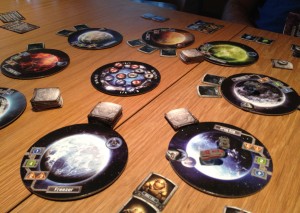 Space Mission is a simple, space-themed game of planetary exploration, but there’s more to it than it first sounds. The goal is to score as many victory points (VPs) as possible which are scored by collecting sets of tiles from the planets and some other ways. On the table are 8 planets each with 8 face-down tiles, and a warp gate in the centre. Each player has a spaceship and starts with a hand of 5 cards. Each card has two numbers on it from 1 to 4 (or a ? which counts as any value) and each number is either green, orange or blue. On their turn, a player can carry out 2 actions (including the same one twice). The 6 actions are:
Space Mission is a simple, space-themed game of planetary exploration, but there’s more to it than it first sounds. The goal is to score as many victory points (VPs) as possible which are scored by collecting sets of tiles from the planets and some other ways. On the table are 8 planets each with 8 face-down tiles, and a warp gate in the centre. Each player has a spaceship and starts with a hand of 5 cards. Each card has two numbers on it from 1 to 4 (or a ? which counts as any value) and each number is either green, orange or blue. On their turn, a player can carry out 2 actions (including the same one twice). The 6 actions are:
- Jump: Discard a card with a blue number and move your spaceship directly to a planet with the same blue number. Place one of your coloured markers on the warp gate.
- Scan: When at an undeveloped planet, discard a card with a green number that matches the planet’s green number to look at that planet’s tiles and reserve one (which you get if the planet gets developed)
- Develop: When at an undeveloped planet, discard two cards with orange numbers that match the planet’s two orange numbers to develop it. Anyone who has scanned and reserved tiles at that planet now receives them, and the developing player takes a tile from the stack too.
- Discover: At any developed planet, take one of the tiles. This action doesn’t cost any cards.
- Fly: Move your spaceship to one of the two planets neighbouring your current location. This action doesn’t cost any cards.
- Draw cards: Discard any cards you want and draw back up to 5 cards. This is the only way to get new cards. Read the rest of this entry »
Tags: board game news, Board Games, board gaming, Space Mission
Posted in Board Game Review, Board Games, Space Mission | No Comments »
Posted by James (admin) on 21st September 2012
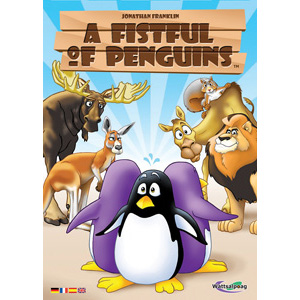 A Fistful of Penguins consists of lots of very cute, clear plastic penguins and some dice which have different animals on each face. On their turn, a player starts by rolling 4-6 dice (depending on which of the 3 rounds it is). After their roll, a player can either (a) stop rolling and cash in their roll, or (b) they can spend one of their penguin pieces to either re-roll any of their rolled dice, or they can roll 1 new dice and add it to their rolled result. Players start with 6 penguins so these options are open to them from the start of the game. Players can keep adding dice and/or re-rolling if they have the penguins to pay for it.
A Fistful of Penguins consists of lots of very cute, clear plastic penguins and some dice which have different animals on each face. On their turn, a player starts by rolling 4-6 dice (depending on which of the 3 rounds it is). After their roll, a player can either (a) stop rolling and cash in their roll, or (b) they can spend one of their penguin pieces to either re-roll any of their rolled dice, or they can roll 1 new dice and add it to their rolled result. Players start with 6 penguins so these options are open to them from the start of the game. Players can keep adding dice and/or re-rolling if they have the penguins to pay for it.
When a player decides to stop rolling, the receive an income based on the various animals they have rolled: Penguins, Lions, Camels, Kangaroos, Squirrels and Moose (1 of each animal on each dice).
- Penguin results earn penguin pieces – you can even cash in dice with penguins on during your turn; however, the more penguins cashed in together, the more penguins the player receives.
- Squirrels mean other players have to give you money in turn order and more squirrels means more money.
- Moose are worth $9 each if they are paired with a squirrel (instead of the normal squirrel effect).
- Kangaroos are worth their total number squared in dollars. If you score kangaroos in the first and/or second round, you get to turn one or two of your dice into kangaroos in the third round.
- Lions are worth $7 each, but if you choose to score lions means only lions and penguins count (and all other animals are worthless).
- Camels are worth $5 each, but $0 if any lions are showing (even if you don’t score them). Read the rest of this entry »
Tags: A Fistful of Penguins, board game news, Board Games, board gaming
Posted in A Fistful of Penguins, Board Game Review, Board Games | 2 Comments »
 From reading the rules, Oddville looks like an interesting mix of using cards to gain resources and tile-laying to build a city. Now that may sound like a lot of other games but the game mechanics of Oddville look inventive and slick.
From reading the rules, Oddville looks like an interesting mix of using cards to gain resources and tile-laying to build a city. Now that may sound like a lot of other games but the game mechanics of Oddville look inventive and slick.








